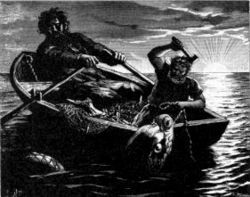
Hymir
Encyclopedia

Norse mythology
Norse mythology, a subset of Germanic mythology, is the overall term for the myths, legends and beliefs about supernatural beings of Norse pagans. It flourished prior to the Christianization of Scandinavia, during the Early Middle Ages, and passed into Nordic folklore, with some aspects surviving...
, Hymir is a giant, husband of the giantess Hroðr and according to the Eddic poem
Poetic Edda
The Poetic Edda is a collection of Old Norse poems primarily preserved in the Icelandic mediaeval manuscript Codex Regius. Along with Snorri Sturluson's Prose Edda, the Poetic Edda is the most important extant source on Norse mythology and Germanic heroic legends, and from the early 19th century...
Hymiskviða
Hymiskviða
Hymiskviða is a poem collected in the Poetic Edda. Its contents are somewhat confusing but can be summarized more or less as follows....
the father of the god Týr. He is the owner of a mile-wide cauldron which the Æsir
Æsir
In Old Norse, áss is the term denoting a member of the principal pantheon in Norse paganism. This pantheon includes Odin, Frigg, Thor, Baldr and Tyr. The second pantheon comprises the Vanir...
wanted to brew beer in; Thor
Thor
In Norse mythology, Thor is a hammer-wielding god associated with thunder, lightning, storms, oak trees, strength, the protection of mankind, and also hallowing, healing, and fertility...
, accompanied by Týr, obtained it from him. He has several daughters.
Hymiskviða and Gylfaginning
Hymiskviða recounts how Thor and Týr obtain the cauldron from Hymir. His skull is unusually hard, and Thor breaks a cup by throwing it at Hymir's head.Hymiskviða also recounts Thor's fishing for Jörmungandr
Jörmungandr
In Norse mythology, Jörmungandr , mostly known as Jormungand, orJörmungand , or Midgard Serpent , or World Serpent, is a sea serpent, and the middle child of the giantess Angrboða and the god Loki...
, the Midgard serpent. Thor goes fishing with Hymir, using the head of Hymir's best ox for bait, and catches Jörmungandr, who then either breaks loose or, as told in the Gylfaginning
Gylfaginning
Gylfaginning, or the Tricking of Gylfi , is the first part of Snorri Sturluson's Prose Edda after Prologue. The Gylfaginning deals with the creation and destruction of the world of the Norse gods, and many other aspects of Norse mythology...
of the Prose Edda
Prose Edda
The Prose Edda, also known as the Younger Edda, Snorri's Edda or simply Edda, is an Icelandic collection of four sections interspersed with excerpts from earlier skaldic and Eddic poetry containing tales from Nordic mythology...
, is cut loose by Hymir. The Prose Edda provides the additional detail that while Thor was attempting to pull Jörmungandr in, his feet went through the bottom of the boat.
Picture stones
This encounter between Thor and Jörmungandr seems to have been one of the most popular motifs in Norse art. Three picture stonePicture stone
A picture stone, image stone or figure stone is an ornate slab of stone, usually limestone, which was raised in Germanic Iron Age or Viking Age Scandinavia, and in the greatest number on Gotland. More than four hundred picture stones are known today. All of the stones were probably erected as...
s have been linked with the story and show Hymir: the Ardre VIII image stone, the Hørdum stone
Hørdum stone
The Hørdum stone is a Viking Age picture stone discovered in Hørdum, Thisted Municipality, North Denmark Region, Denmark, that depicts a legend from Norse mythology involving the god Thor and Jörmungandr, the Midgard serpent.-Description:...
, and the Gosforth Cross
Gosforth cross
upright|thumb|Gosforth Cross outside St Mary's church in Gosforth.The Gosforth Cross is a large stone Anglo-Saxon high cross in the churchyard at Gosforth in the English county of Cumbria. Formerly part of the kingdom of Northumbria, the area was settled by Scandinavians some time in either the 9th...
. A stone slab that may be a portion of a second cross at Gosforth also shows a fishing scene using an ox head for bait. The legend is also depicted on the Altuna Runestone
Altuna Runestone
The Altuna Runestone , listed as U 1161 in the Rundata catalog, is a Viking Age memorial runestone with images from Norse mythology that is located in Altuna, Uppland, Sweden.- Description :...
, but its image does not show Hymir, possibly due to the narrow shape of that stone.

